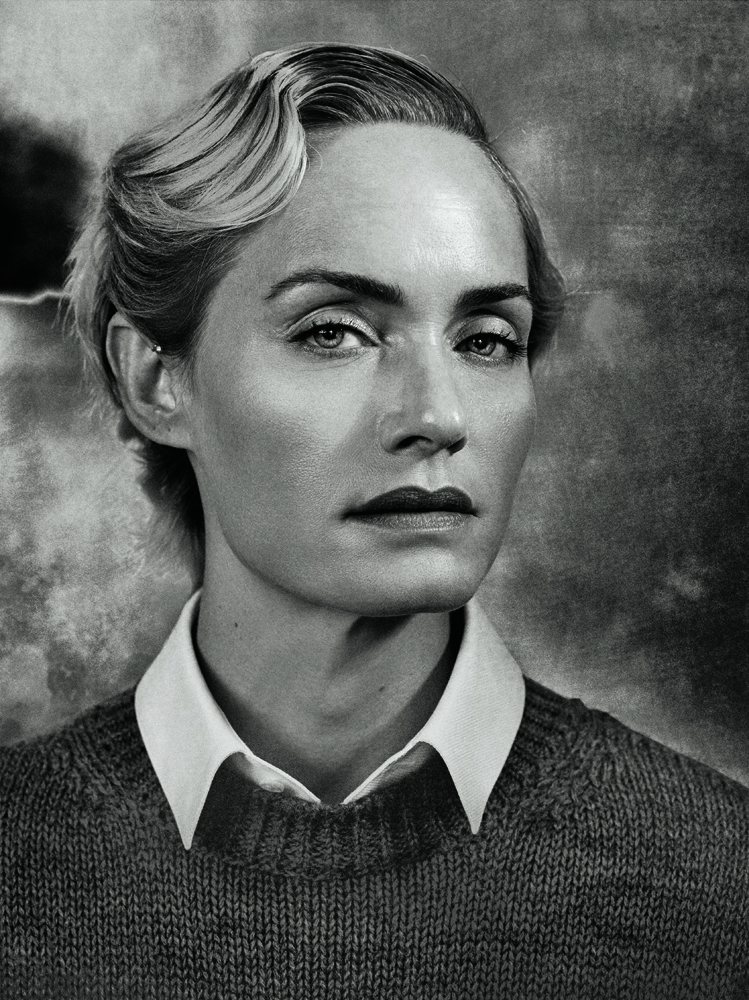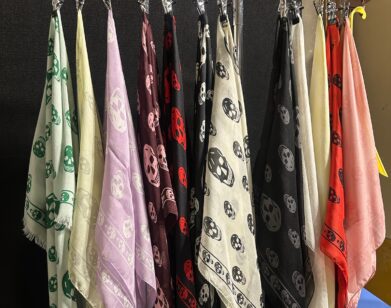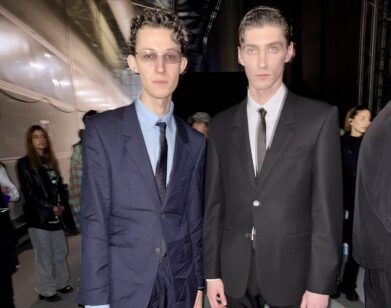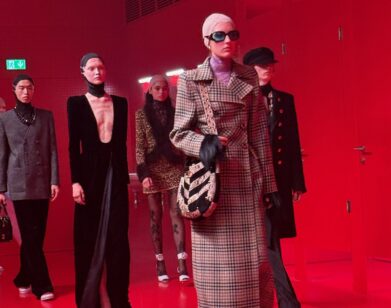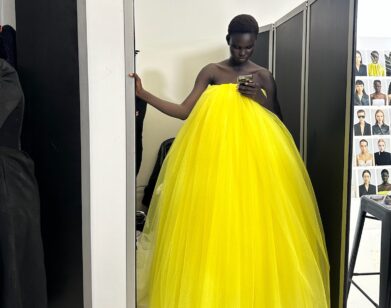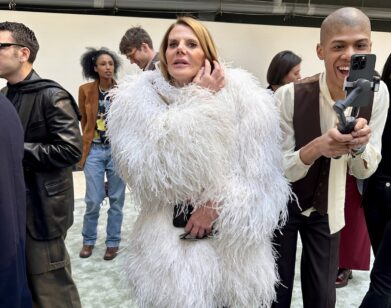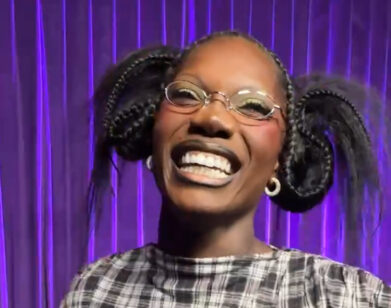Amber Valletta by Craig McDEAN
I WAS MORE INTO FASHION than I WAS INTO PHOTOGRAPHY. I USED TO GO TO all these CLUBS WHERE PEOPLE would DRESS UP. I SHOULD HAVE BEEN STUDYING or WHATEVER, BUT I WASN’T. Craig McDean
It’s fitting that one of the early loves of British export Craig McDean was music. The photographer, who currently lives in New York with his wife, the shoe designer Tabitha Simmons, and their children, grew up frequenting clubs and shooting local bands in Manchester in the ’80s. And he’s translated that subcultural fluency into a career creating lyrical, graphic, and kinetic images for Interview, Vogue, and i-D and brands like Valentino, Yves Saint Laurent, and Yohji Yamamoto—while regularly taking striking portraits of rock royalty (Yoko Ono, Thom Yorke, and Jay Z among them) along the way.
After dropping out of art school and then assisting fellow Brit Nick Knight in London, McDean came into his own in the minimal-minded ’90s with campaigns for Calvin Klein and Jil Sander. His early assignments led McDean to one of his dearest friends and longtime subjects, supermodel and actress Amber Valletta, with whom he’s collaborated for over 20 years. When they caught up via phone in late July, Valletta got a rare chance to put McDean under the lens.
AMBER VALLETTA: Do you remember the first time we met?
CRAIG McDEAN: It was in 1993. We made you silver for French Glamour. We’ve worked together ever since.
VALLETTA: You saw me differently than anybody I’d ever worked with. You allowed me to be the kooky, crazy kid that I was. There’s a bit of madness, too, that happens when we work together.
McDEAN: That was the fun that came out of it. That was at the very beginning of my career. I was totally new as well, humping this big old 8-by-10 plate camera around. I still look at the pictures today, and I still love them to death. We shot with [makeup artist] Pat McGrath and [hairstylist] Eugene Souleiman. We all didn’t know what we were doing—let’s face it. [laughs]
VALLETTA: No, we didn’t. [laughs] But we figured it out together.
McDEAN: Yeah. It’s like a band, everyone having their say and experimenting. It was a wonderful day.
VALLETTA: I know you photographed rock bands early on. What were you like as a kid?
McDEAN: Probably not the greatest kid at school. I should have done better, but …
VALLETTA: Well, I imagine that you were very smart. Why didn’t you do better?
McDEAN: I don’t know. I was really into music and I spent a lot of time in Manchester jamming around. I also had a great love of fashion, especially what was coming out of London. Growing up in Manchester was a big inspiration. The Happy Mondays were just coming out, and the Stone Roses. Before that was the Clash and that punk attitude. I was very young at the time, but I was interested in that dress sense and what was going on. I was more into fashion than I was into photography. I used to go to all these clubs where people would dress up. I should have been studying or whatever, but I wasn’t. [laughs]
VALLETTA: Well, it paid off. Did you have any hobbies?
McDEAN: I was into motorcycles from a very young age, so on the weekends I went to motocross and was documenting that. My father was an amateur filmmaker, and I started taking photographs from a young age. I never thought that I would make a profession out of it. It was just something that interested me—recording. To be honest, at the time, I was more interested in war photography. National Geographic was my favorite magazine as a kid.
VALLETTA: Do you ever dream of doing stuff like that now?
McDEAN: Of course. I guess the closest I’ve ever gotten is the sumo wrestlers [McDean’s 1990s photographs of sumo wrestlers in Japan were published in 2011’s Sumo]. Most of my college projects were photographing landscapes, so I did that for years. When I went car-racing, I documented the whole thing. I got to see a lot of America doing that.
VALLETTA: You studied photography. When did you go to London and get into fashion?
McDEAN: I was at Blackpool [and the Fylde] College but left before I finished my degree. I was looking at a lot of photographers at the time, and I really loved what Nick Knight was doing in i-D. I wasn’t that big a reader of fashion magazines. I just wrote to Nick and [stylist] Charlotte [Stockdale], asking, “Is there any place I could stay? Could you give me a job?” I was coming to London to see museums and exhibitions, so I stopped by Nick’s printer’s one day when he was printing a story for Arena Homme Plus. I sat with him, talking for hours, and then I said, “I’ll come down next week and work for free.” That was where it all started.
VALLETTA: Would you hire someone now if they wrote to you? Would you give them time and energy if you talked to them and liked them?
McDEAN: Definitely. A lot of my assistants come that way.
VALLETTA: That’s so cool. What did you admire about Nick’s work?
McDEAN: It was something I’d never seen before in photography. He was doing these beautiful catalogs with [graphic designer] Peter Saville for Yohji Yamamoto. To see those pictures of Susie [Bick] smoking [for Yamamoto’s Fall/Winter 1988 ad campaign]; it was just so ahead of his time.
VALLETTA: I imagine he’s still a great friend of yours.
McDEAN: Every time I’m in London, I see him. I never saw myself as an assistant. I just saw myself as a friend, hanging out and talking to him about photography for hours, late nights and evenings. We were best friends. Did you ever work with him?
VALLETTA: I did. I worked with Nick a lot back in the ’90s. I just remember how gentle he was. There was always flexibility, but he also knew exactly what he wanted. The interesting thing for me about working with different photographers was, once you’ve worked with them, you know their style, you know their mood, the way they move creatively. I shape-shift. I bring a part of myself, but my job is to interpret what they’re dreaming.
McDEAN: It’s funny because when I photographed you, you always seemed to “get it.” [laughs] I would say something like, “I don’t want something that’s normal,” and you always seemed to have it.
VALLETTA: I think that is from working together a long time, but I also think the people you work with best are the people who you connect with on a deeper level. If it’s somebody I can’t interpret, then I can’t give them, ultimately, what they’re looking for. I mean, you and I have been good friends for, like, 20 years, right?
McDEAN: Oh my God, we’re like soul mates.
VALLETTA: What were some of your first big breaks in fashion? I know the Jil Sander campaign [in 1995] was big. And Calvin Klein [in 1995].
McDEAN: The Jil Sander campaigns, with you and then Guinevere [van Seenus, in 1996], wrote a new chapter in my life. Coming to America and working for W magazine with Dennis Freedman, that was really the launch pad in America. Then, Harper’s Bazaar and Fabien Baron. It was such a creative place to work. But, going back to Jil Sander and working with [art director] Marc Ascoli, and the very late nights …
VALLETTA: [laughs] Yeah, we put in some long hours.
McDEAN: Up to two, three in the morning? I don’t know.
VALLETTA: I think at five everyone started discussing the meaning of a sweater.
McDEAN: We were talking about a shirt for, like, four hours.
VALLETTA: [laughs] It’s funny, I don’t remember tons of shoots, but I remember almost all of our shoots. I wanted to ask you about the other women you’ve worked with over the years and how they inspired you. Kate [Moss], Shalom [Harlow], and Guinevere [van Seenus] have been big. Especially Guinevere and Kate, because you did a book [Amber, Guinevere, & Kate Photographed by Craig McDEAN: 1993-2005] with all three of us.
McDEAN: The most important thing is that, when you work with somebody, you build a rapport with that person. They have a certain trust in you. You don’t have to explain that much. It’s very hard when you photograph someone who’s a fresh face and then you don’t work with them again for six months. All these people I work with over and over again have qualities that I love. There’s something very free about them or there are some slight imperfections about them. I think the more you work with someone, the pictures get better and better. To tell you the truth, all you girls make my life so easy.
VALLETTA: Even though we’re getting older and the lines are getting harder? [laughs]
McDEAN: You just can’t work till three in the morning anymore, that’s all. I get it. Me neither.
VALLETTA: Would you ever make a film?
McDEAN: I start filming in September.
VALLETTA: What are you shooting?
McDEAN: Oh, fuck, I don’t want to say. It will be revealed soon.
VALLETTA: We should make a short. That would be cool.
McDEAN: I won’t kill you in 20 minutes though, Amber.
VALLETTA: You promise? My TV show, Revenge, tried to kill me, like, four times and I kept surviving. [McDean laughs]
McDEAN: You keep coming back. That’s amazing. You’re like a cat, really. What haven’t you done that you’d like to do?
VALLETTA: I’d like to do a sick feature film with somebody like David Lynch. Fashion has seen me like that, but film hasn’t. They always want to make me the pretty girl next door. They don’t realize how twisted I am. [laughs]
McDEAN: I could give them a whole dossier of that. Well, I’ll try to write a film for you. I’ll work a twisted film for you. Okay?
AMBER VALLETTA IS A MODEL AND ACTRESS CURRENTLY LIVING IN LOS ANGELES.
For more from the Photographers’ Portfolio, click here.

